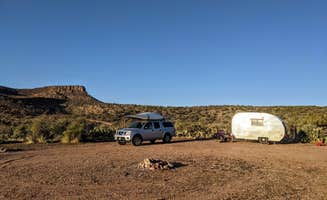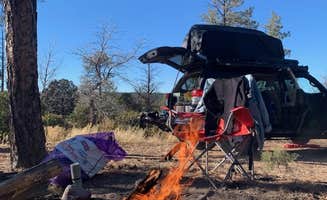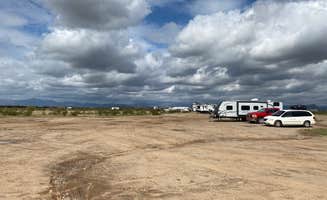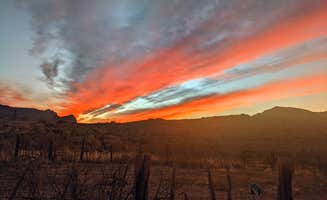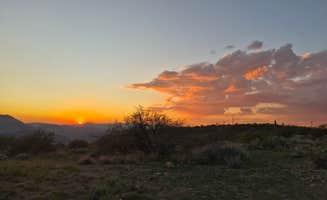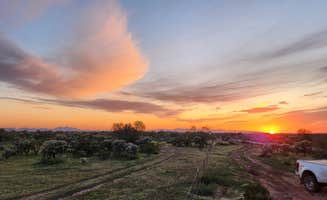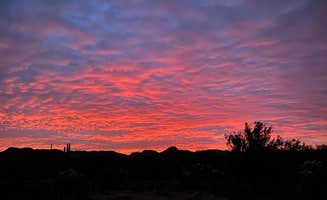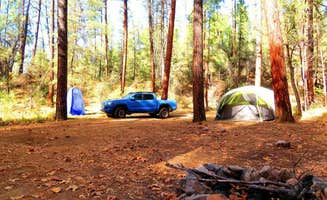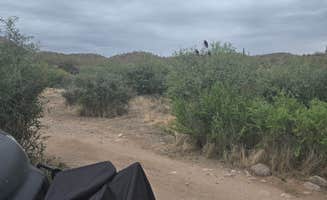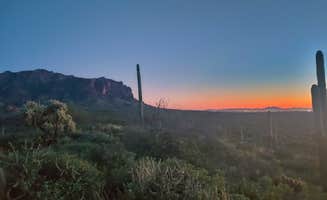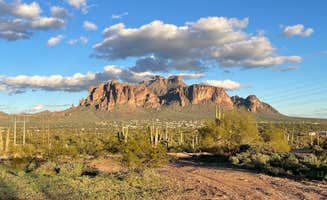Roosevelt Lake and Tonto National Forest offer extensive primitive camping near Globe, Arizona, with campsites ranging from accessible lakeside locations to remote mountain hideaways. The region sits at approximately 2,500 feet elevation, with the surrounding mountains rising to over 7,000 feet. Seasonal visitors contend with extreme temperature variations, from winter frosts to summer heat waves that require extra water supplies and shade options.
What to do
Morning wildlife watching: At EADS Wash, early risers can observe desert wildlife during cooler hours. "We camped about 100 feet from the river but were able to easily hear the water running all night. Being in a wash did effect the temperature a lot. We saw freezing temperatures at night (long enough to form ice in our jugs of water) and low 80s during the day," notes Krista Z.
Water activities: Access the river at Flat Lands by River/Bridge Dispersed for swimming during warmer months. "Stairs down to river er beach. Quiet, only one other camper in May. Water still a bit cold," reports Mark F. These designated access points help protect fragile shorelines while providing recreation opportunities.
Desert trail exploration: Multiple hiking paths from Eucalyptus campground connect to the surrounding desert ecosystem. "It's a beautiful area but people haven't been cleaning up after themselves and there's a lot of beer cans and fishing line scattered around. There's a lot to explore and it wasn't crowded at all," explains Alex T. Remember that summer temperatures limit hiking to early morning hours only.
What campers like
Solitude and darkness: Campers at Schoolhouse Point Dispersed appreciate the distance from urban light pollution. "Pretty, dispersed camping near Schoolhouse Point in Roosevelt lake... Probably 20+ sites at each of the two pull offs, most have fire rings and decent shade," shares Cypress. This allows for exceptional stargazing experiences on clear nights.
Winter camping comfort: The moderate winter temperatures make Tonto National Forest ideal for winter camping. "We stayed here on February 19th and 20th of 2022. The weather was great! High of 78 and mid 40's at night. I pulled off of the main road 188 onto 83 which is a dirt road. The road was easy to navigate," explains Monte W., who camped at Roosevelt Lake.
Wildlife encounters: Many campers report memorable wildlife sightings, including coyotes, cattle, birds, and reptiles. "Beautiful desert camping, lots of birds and wildlife. I heard coyotes in the middle of the night that woke me up, and was glad for a rooftop tent," notes Cas M. Cattle encounters are common on the working ranges around the lake.
What you should know
Road conditions vary significantly: Many access roads deteriorate quickly after rain. "There is a dirt road off to the left as you enter the area that you can use to get to campsites but it is for high clearance vehicles and 4 wheel drive only. Most of the area on the dirt road has powdered dirt and it was easy to get stuck," warns Krista Z. about Eucalyptus campground.
Water sources are limited: Despite camping near a river or lake, drinking water remains scarce. "We usually bring a water filter if we are camping by a river or stream, but this is the upper salt river and even when you filter it the water tastes extremely salty so we brought water with us," explains Alex T., highlighting the importance of bringing sufficient water supplies.
Permit requirements: Arizona State Trust Lands require permits for camping. At Cottonwood Canyon Rd. Dispersed, "This is Arizona State Trust Land so a permit is required but can be purchased and downloaded from their website at a cost of $21.00 and it is valid for 1 year for the family pass," explains Robo A.
Tips for camping with families
Temperature preparation: Families need extra clothing layers for desert camping. "We were there in the middle of January. Waking up to everything covered in frost was a pleasant surprise since it was around 70 during the day. Be prepared for the temperature change," advises Keith J., who stayed at EADS Wash.
Wildlife viewing opportunities: Children often enjoy observing desert wildlife. At Cottonwood Canyon, campers report unique experiences: "Cows everywhere, wake up and have a good cup of coffee & conversation with a couple of bovine," notes Steve T. These encounters provide educational opportunities about desert ecosystems.
Cactus safety measures: The prevalence of cacti requires special precautions with children. "Use caution when walking about between the cacti. Lots of prickles you can't see well on the ground. Be extra careful if you have dogs. Probably want to have tweezers or pliers with you to remove the spines," advises Sammy S., who camped at Cottonwood Canyon.
Tips from RVers
Site selection strategy: RVers should scout locations before committing to spots. "Can get dusty from riders if you stay near the front. If you take some time to come scout it out you can find some great spots," suggests Steve T. about Cottonwood Canyon camping.
Water planning: RVers need to budget water carefully and know refill locations. "Currently (as of 3/24) no potable water even at the paid campground at the end of the road, you can either pump from the lake if you have a filter or Tonto national monument about 10min up the road has a water spigot before the pay gate," advises Cypress.
Boondocking duration: Many sites allow extended stays for self-contained RVs. "14 day limit per usual for national forests but a really lovely spot to call home for a while! Lots of great hiking nearby as well as swimming and boating on the lake," notes Cypress about the dispersed camping at Schoolhouse Point.


